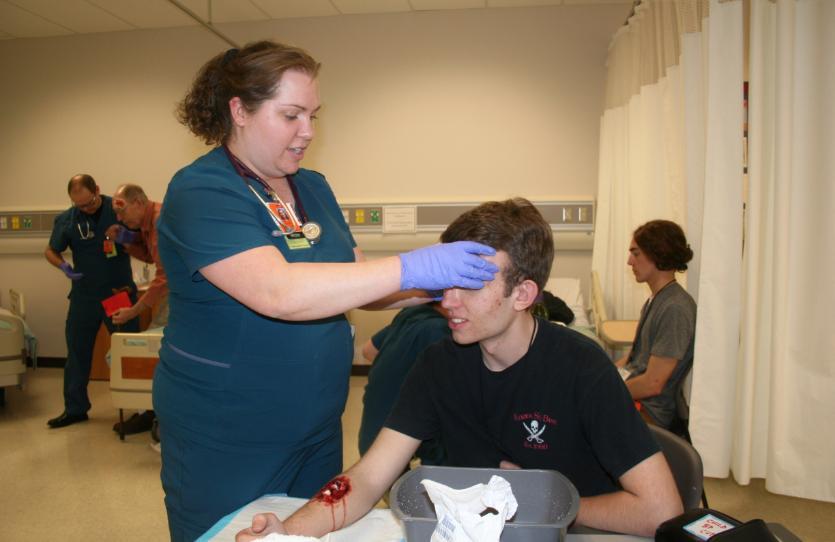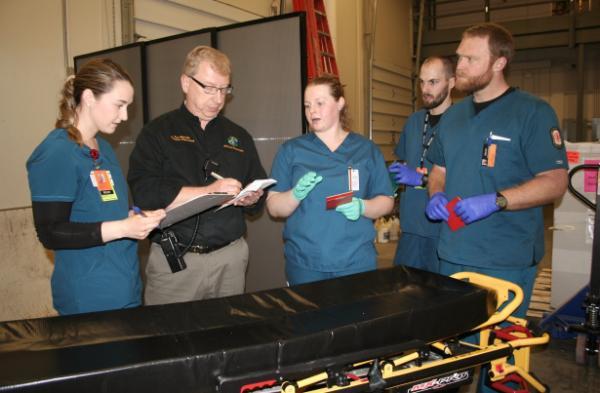ISU-Meridian nursing students test skills in mock disaster

ISU accelerated nursing student Sarah Phelan treats victim Caleb Ankeny in mock disaster exercise at ISU-Meridian.
April 24, 2018
MERIDIAN—Here’s the scenario. Nurses are attending a professional conference at Idaho State University-Meridian when an airplane crashes on busy I-84 next to campus.
The scene is chaotic—shrapnel and debris are scattered everywhere, survivors are trying to flee the fire and fumes. Dozens are injured, some critically.
The visiting nurses have to change gears quickly. No longer is the conference their focus. They must work together to save lives in what appears to be a catastrophic disaster.
“They need to figure out how to mobilize as a team, how best to respond to help survivors. That’s the purpose of this simulation exercise,” said Jennifer Hackwith, clinical assistant professor and program coordinator of ISU-Meridian’s postbacclaureate nursing program.
The “responding nurses” are students enrolled in ISU’S rigorous 12-month accelerated nursing program. Hackwith and her staff added disaster preparedness to this year’s curriculum after global and national agencies, including the World Health Organization and American Nurses Association, recommended postbacclaureate nursing programs do so. Advocates say disaster training for health professionals is vital in a world where mass shootings, terrorist attacks and catastrophic disasters near population centers are a threat.
“Nurses have to be prepared to handle them,” said Rebekkah Hulen, associate professor of nursing.
Inside the simulation
The nursing department became an emergency setting with designated areas for triage, treatment and transport of victims. In this mock situation, crews were able to gather resources used to teach nursing skills in the Meridian curriculum—beds, wheelchairs, gurneys, medical equipment, and supplies for wound care and broken limbs—something they would expect to do in a real-world situation as well.
Thanks to hand-held radios and a red liquid that simulated blood, the exercise sounded and looked like the real thing. “I have a guy with burns on his right arm, where should he go?” emanated a voice from a radio.
Another voice quickly reported a victim with no physical injury, but who appeared to be in shock.
Once emergency crews—representatives from ISU and Ada County paramedics programs—triaged the victims, they sent them to color-coded areas for treatment or stabilization until an ambulance arrived. The most severely injured were coded red, followed by yellow and green.
Nursing student Sarah Phelan says the exercise was invaluable. “It gave me a lot of experience on how to prepare for an emergency which I’ve never experienced before. Without the exercise, I’m not sure I’d know what to expect,” she said as she placed a splint on the broken arm of a survivor.
Classmates Kyle Gebs, who helped stabilize the more serious wounds, and Shana Fehrs, who helped coordinate communications with outside agencies, said the exercise pushed them out of their comfort zones, forcing them to confront the unfamiliar, work as a team and make the best use of limited resources.
“This was a new experience for me. I think it will help to better prepare me for any crisis,” said Gebs, noting much of his current training had focused on in-hospital care with a single patient and not in a setting with mass casualties.
During the simulation, teams treated 22 victims—who were actual students from Renaissance High School’s emergency medical technician program—for broken bones, lacerations, internal injuries, respiratory issues and shock. There was one fatality.
Fehrs said simulations are lessons that can’t be duplicated in textbooks.
“There is no better place to make your mistakes or experience confusion than in a mock situation. I believe if a similar emergency happens in real life, I’ll be better prepared. I’ll be ready,” she said.
To find out more about the accelerated nursing program—the only one of its kind in Idaho—visit www.isu.edu/nursing/programs/accelerated-bachelor-of-science-in-nursing/.
Team gathers in triage area during mock disaster exercise at ISU-Meridian. Left, nursing student Kaitlin Cooley, ISU Paramedic Program Director Rod Hackwith, nursing students Kailey Swearingen, Kyle Gebs and Troy Watson.
###

